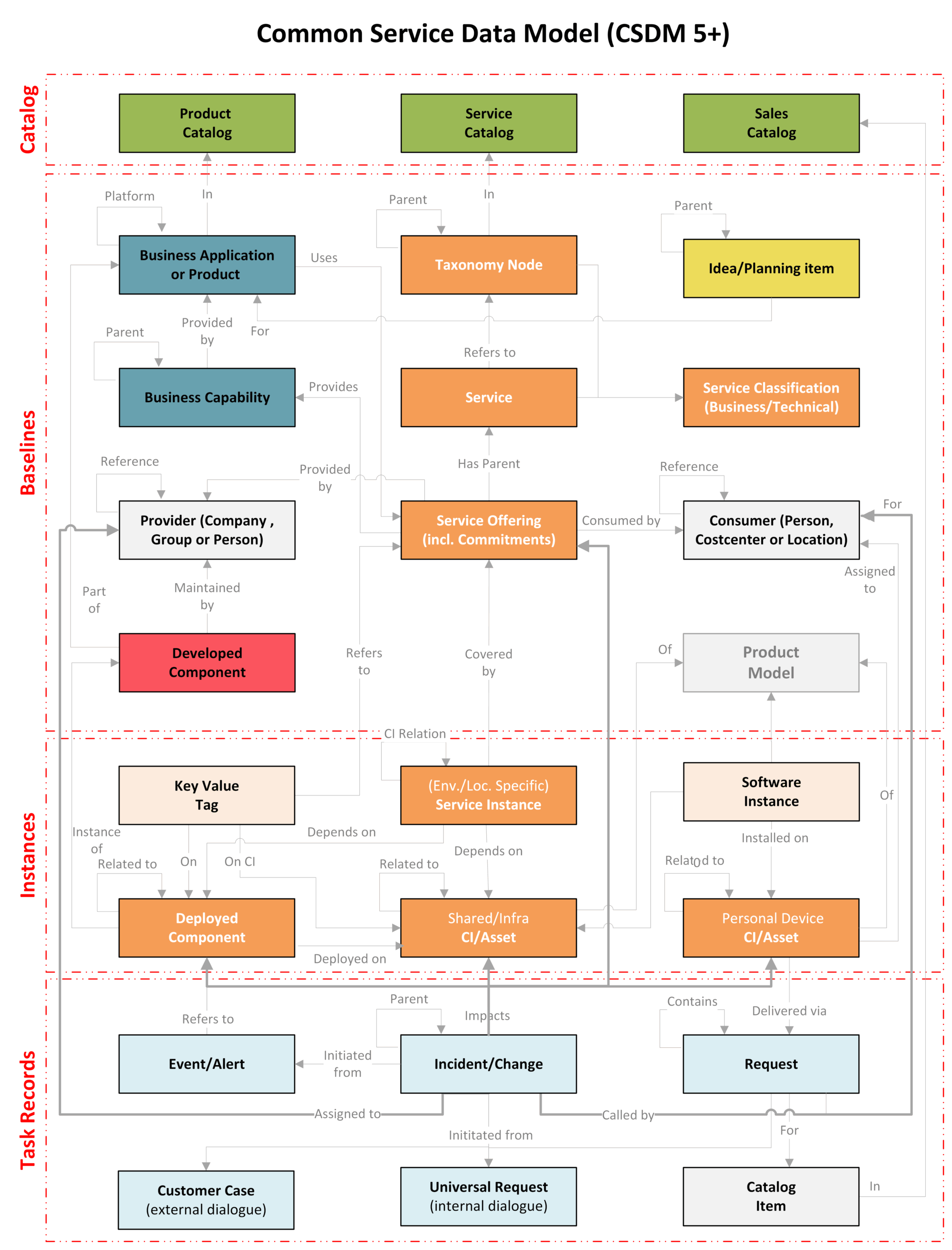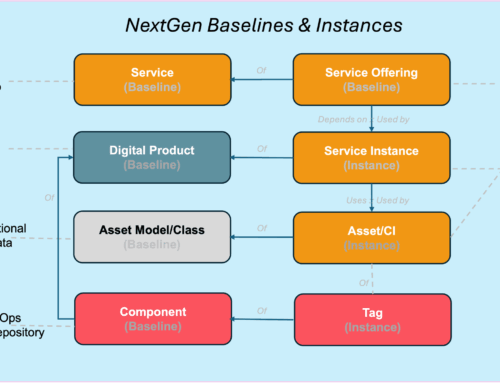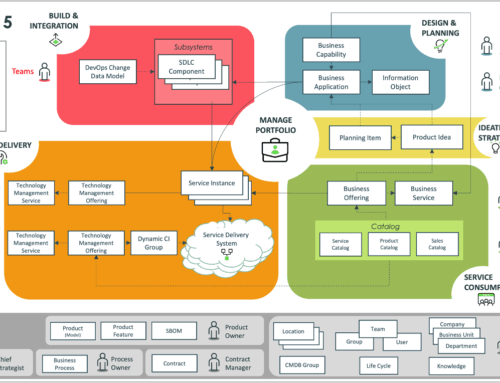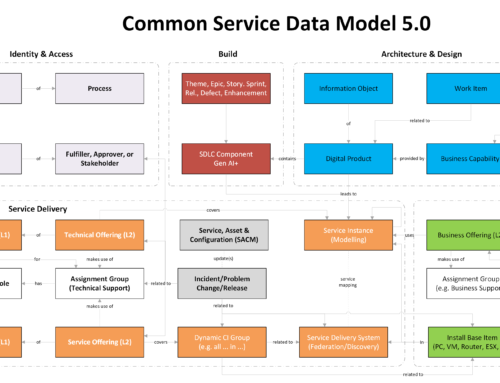How do Incidents, Changes, Problems, Events, Requests, Cases, Assets, and Dialogues connect to ServiceNow's Common Service Data Model (CSDM 5)? The answer is CSDM 5+: a practical extension that shows the bigger picture, clarifies concepts, and provides implementation guardrails.
0. INTRODUCTION
CSDM 5 defines six domains:
- Ideation & Strategy
- Design & Planning
- Build & Integration
- Delivery
- Service Consumption
- Foundation
These domains align closely with the IT4IT v3 Value Chain.
CSDM 5+ reframes this into five interconnected layers, making the structure easier to apply in practice:
- Foundation – master data: companies, org units, locations, currencies, languages, etc.
- Catalogs – structured portfolios with accountable owners.
- Baselines – products, components, and services defined "on paper."
- Instances – deployed versions of baselines, detectable in the IT landscape.
- Tasks – records of what happens to instances.
Some organizations define their own content. Others import out-of-the-box definitions (e.g., from the TBM Council). Both approaches are valid—success depends on governance, maturity, and scale.
Versioning in CSDM 5+
- Services, Offerings, Products → not versioned (their instances may differ).
- Components → always versioned (new minor version = new baseline).
- Instances → versioned if detectable.
- Upgrades update version attributes; Migrations create new items and retire old ones.
1. FOUNDATION
The Foundation layer provides shared master data:
- Organizational structure: Companies, Business Units, Departments
- Geography: Locations, Regions, Countries, States/Provinces
- Standards: Currencies, Languages, Time Zones
- Processes: Business Processes, Value Chains
- People: Groups, Roles, Employees, Memberships
Foundation data is stable and not versioned.
2. CATALOGS
CSDM defines three core catalogs:
- Product Catalog – managed applications and technical products.
- Service Catalog – business and technical services plus their offerings.
- Sales Catalog – items available to internal/external request.
Additional ServiceNow catalogs include:
- Program & Project Portfolio – demands, projects, agile artifacts.
- DevSecOps Repositories – product components under development.
3. BASELINES
3.1 Products
Products are coarse-grained items with managed lifecycles (software, hardware, cloud).
- Governed by Digital Product Management.
- Not versioned as baselines; their instances are.
- Enable one or more business/technical capabilities.
Examples:
- Notepad++ → not a Product (no lifecycle governance).
- Dell Latitude 7450 → managed via Asset Management, not Product Management.
3.2 Components
Fine-grained parts of Products: modules, configurations, cloud resources, files, or properties.
- Belong to one Product.
- Always versioned (minor-level).
- Created and deployed through CDAAS / DevSecOps pipelines.
3.3 Services
Services are delivered by Providers and consumed by Consumers.
- Business Services → enable business outcomes.
- Technical Services → enable/support Business Services.
- Not versioned and product-agnostic.
Service Offerings:
- Variants of Services with commitments (region, environment, SLA).
- Belong to one Service.
- Not versioned.
4. INSTANCES
4.1 Service Instances
Real-world deployments of Services.
- Example: Development, Test, and Production are separate instances.
- Example:
company-prd.service-now.comsupports multiple offerings (IT, HR). - APIs, portals, and AI agents are also Service Instances.
4.2 Configuration Items (CIs)
Detectable deployed items: servers, VMs, PCs, cloud resources, IPs, files.
- Tracked across ~1,500 CMDB tables.
- Can be tagged (e.g.,
Environment=Production).
4.3 Software Instances
Detected installations stored outside CMDB.
- Millions of records: OS components, packages, agents.
- Some licensed, others bundled or free.
- Not all are Assets.
4.4 Assets
Items with monetary value or assignment to a consumer.
- Managed via Asset Management.
- SAM normalizes detected software instances to licensing rules.
- Cloud licenses (O365, JIRA, SAP, ServiceNow, etc.) are tracked here.
5. TASKS
Tasks capture activity on Instances. Regardless of whether executed by people, bots, or AI, records are essential for collaboration and traceability.
5.1 IT Task Records
- Incidents – service interruptions or degradations.
- Events/Alerts – warnings or triggers.
- Changes – release of component instances.
- Requests – product/service delivery.
5.2 Customer & HR Task Records
- Customer Cases – external issues/requests.
- HR Cases – employee issues/requests.
- Work Orders – field services, maintenance.
5.3 Other Governance
- Products & demands – via Strategic Portfolio Management.
- Services & Offerings – via Digital Portfolio Management.
- IAM roles & entitlements – managed separately.
Note: In Agile/SAFe setups, Problem Management often becomes redundant. Defects and enhancements are logged directly as stories.
Linking Tasks to Artefacts
Tasks must always be tied back to artefacts for consistency:
- Foundation data – impacted organization, location, department.
- Consumer (mandatory) – determines eligible offerings.
- Service Offering (mandatory) – defines provider, commitments, subscriptions.
- Impacted Instance (CI) – service instance or CI covered by the offering.
Best practices:
- Separate offerings for production vs non-production.
- Use standard product definitions (COTS).
- Organization-specific variants → model them as offerings, not Products.
- Dependency maps should show upstream products/capabilities and downstream CI trees.
OUTLOOK
CSDM 5+ will continue to expand, adding artefacts from:
- SecOps
- DevOps
- IRM & GRC
- Identity & Access Management (IAM)
Together, these will complete the "bigger picture" of how ServiceNow artefacts interconnect.
Key Takeaway
CSDM 5+ makes the model practical:
- Foundation defines the context.
- Catalogs capture intent.
- Baselines define design.
- Instances represent reality.
- Tasks record what happens.
When connected, they provide the clarity needed to manage IT consistently and at scale.







Geef een reactie